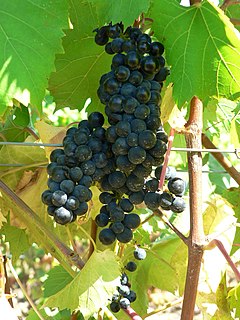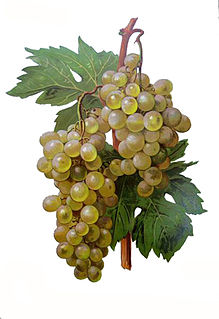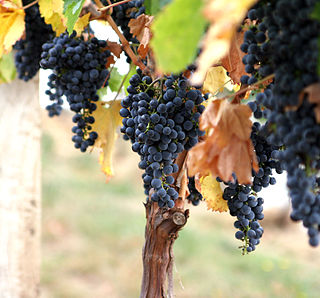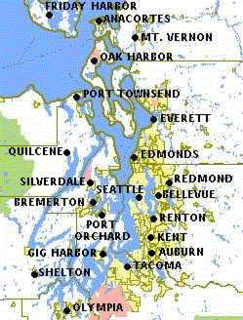For the 1931 French transport ship, please see here.
Marechal Joffre is a red inter-specific hybrid grape variety created by French viticulturist Eugène Kuhlmann (1858–1932). Like Marechal Foch, [1] which was also created by Kuhlman, Marechal Joffre is named after a notable French World War I general, in this case Marshal (Fr. Maréchal ) Joseph Joffre. [2] [3]

Hybrid grapes are grape varieties that are the product of a crossing of two or more Vitis species. This is in contrast to crossings between grape varieties of the same species, typically Vitis vinifera, the European grapevine. Hybrid grapes are also referred to as inter-specific crossings or "Modern Varieties." Due to their often excellent tolerance to powdery mildew, other fungal diseases, nematodes, and phylloxera, hybrid varieties have, to some extent, become a renewed focus for European breeding programs. The recently developed varieties, Rondo, and Regent are examples of newer hybrid grape varieties for European viticulturalists. Several North American breeding programs, such as those at Cornell and the University of Minnesota, focus exclusively on hybrid grapes, with active and successful programs, having created hundreds if not thousands of new varieties.

Maréchal Foch is an inter-specific hybrid French red wine grape variety. It was named after the French marshal Ferdinand Foch (1851-1929), who played an important role in the negotiation of the armistice terms during the closing of the First World War. It was developed in Alsace, France, by grape hybridizer Eugene Kuhlmann. Some believe it to be a cross of Goldriesling with a Vitis riparia - Vitis rupestris cross. Others contend that its pedigree is uncertain and may contain the grape variety Oberlin 595. It ripens early, and it is cold-hardy and resistant to fungal diseases. The berry size is small, which makes it prone to bird injury. The quality of wine produced by Marechal Foch vines is highly dependent upon vine age, and the flavor profile associated with many new-world hybrid varietals is much reduced in examples made with fruit picked from older vines.

World War I, also known as the First World War or the Great War, was a global war originating in Europe that lasted from 28 July 1914 to 11 November 1918. Contemporaneously described as "the war to end all wars", it led to the mobilisation of more than 70 million military personnel, including 60 million Europeans, making it one of the largest wars in history. It is also one of the deadliest conflicts in history, with an estimated nine million combatants and seven million civilian deaths as a direct result of the war, while resulting genocides and the 1918 influenza pandemic caused another 50 to 100 million deaths worldwide.
Contents
The grape is a crossing of the Vitis vinifera variety Goldriesling and another inter-specific crossing Millardet et Grasset 101-14. [4] Through Millardet et Grasset 101-14, the pedigree of Marechal Joffre includes varieties from other species in the Vitis genus including Vitis riparia and Vitis rupestris . [5]

Vitis vinifera, the common grape vine, is a species of Vitis, native to the Mediterranean region, central Europe, and southwestern Asia, from Morocco and Portugal north to southern Germany and east to northern Iran. There are currently between 5,000 and 10,000 varieties of Vitis vinifera grapes though only a few are of commercial significance for wine and table grape production.

Goldriesling is a grape variety of the species Vitis vinifera used for white wine. It was created in 1893 by Christian Oberlin in Colmar, Alsace by crossing Riesling with another grape variety, which is sometimes given as Courtillier Musqué Précoce, but not identified conclusively.
A genus is a taxonomic rank used in the biological classification of living and fossil organisms, as well as viruses, in biology. In the hierarchy of biological classification, genus comes above species and below family. In binomial nomenclature, the genus name forms the first part of the binomial species name for each species within the genus.












